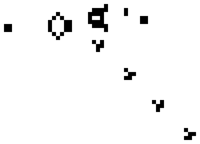
Photo from wikipedia
Summary Communicating cells can coordinate their gene expressions to form spatial patterns, generating order from disorder. Ubiquitous “secrete-and-sense cells” secrete and sense the same molecule to do so. Here we… Click to show full abstract
Summary Communicating cells can coordinate their gene expressions to form spatial patterns, generating order from disorder. Ubiquitous “secrete-and-sense cells” secrete and sense the same molecule to do so. Here we present a modeling framework—based on cellular automata and mimicking approaches of statistical mechanics—for understanding how secrete-and-sense cells with bistable gene expression, from disordered beginnings, can become spatially ordered by communicating through rapidly diffusing molecules. Classifying lattices of cells by two “macrostate” variables—“spatial index,” measuring degree of order, and average gene-expression level—reveals a conceptual picture: a group of cells behaves as a single particle, in an abstract space, that rolls down on an adhesive “pseudo-energy landscape” whose shape is determined by cell-cell communication and an intracellular gene-regulatory circuit. Particles rolling down the landscape represent cells becoming more spatially ordered. We show how to extend this framework to more complex forms of cellular communication.
Journal Title: iScience
Year Published: 2018
Link to full text (if available)
Share on Social Media: Sign Up to like & get
recommendations!